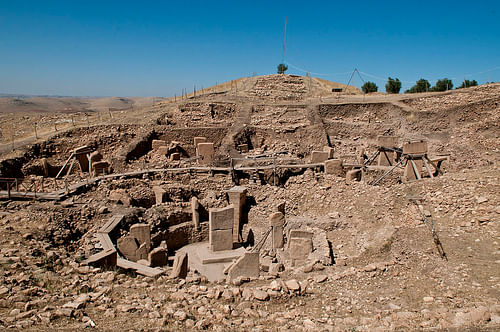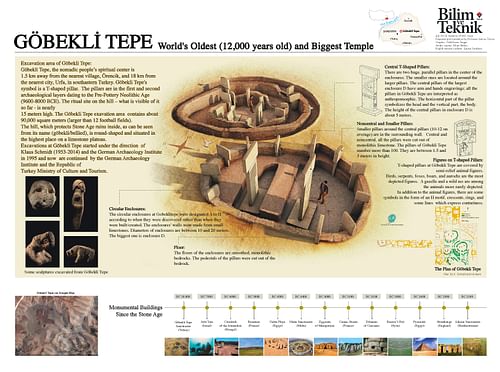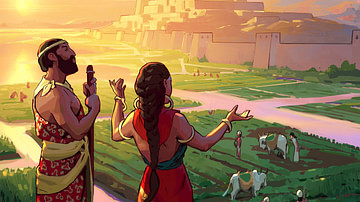
“Göbekli Tepe” (“Hill with a Navel”, or “Potbelly Hill”) is found approximately 16 km (10 miles) northeast of Şanlıurfa, an ancient city in southeastern Turkey once named “Edessa” and known as “the City of the Prophets”. While this nearby city has a rich religious history, just how far back religion stretched in this region was unknown until the discovery of “Göbekli Tepe”. The site is listed by UNESCO as a World Heritage Site.
Architecture & Art
The site is the oldest man-made place of worship yet discovered, dating back to 10,000 BCE. The temples were discovered by a German archeologist (Klaus Schmidt) who had previously worked on the Nevalı Çori site and dig, which is now known to be predated by Göbekli Tepe. The temples contain 3 metre (10 ft) pillars situated in the round. Each T-shaped monolithic limestone pillar contains carved reliefs of animals – gazelles, snakes, foxes, and lions – as well as abstract characters and icons. Bones that have been discovered at the site suggest the hill was used for ritual sacrifices and feasts.
Found in the cradle of civilization, “Göbekli Tepe” (Potbelly Hill in English) is rightfully named. As you drive through the surrounding villages (Derman Köyü, Göktepe Köyü, and Örencik Köyü) – one of two ways to get to the site – you are directed to the ancient temple by signs spray-painted on the wall. Then you slowly drive up the hills in between fields that have been worked by farmers for centuries until you see it, like a middle-aged man lying on his back with his shirt off, “Potbelly Hill” stands as the highest point in the area.
The hunter-gatherers who built the temple lived in a world that predated writing, metal, or pottery, and at a time when archaeologists thought humanity had yet to group together to worship with priests and sacrifices, yet these Neolithic worshippers somehow organized themselves and found a way to cut and transport these 16-ton stone pillars up a hill and arrange them in a circular, ritualistic pattern.
The hill was littered with an enormous amount of Neolithic flint tools – knives, choppers, and projectile points. These tools are not out of the ordinary, but the sheer number of them is something of a phenomenon, and the fact that they were used to build a religious site, in a time when many historians and archeologists believed temples and religious practices of this kind did not yet exist, makes this an even more interesting discovery.
Significance in Understanding the Development of Religion
The historian K.Schmidt believed that what he called this "cathedral on a hill" was a pilgrimage destination attracting worshippers up to 160 km (100 miles) distant. The discovery of Göbekli Tepe “suggests, at least to the archaeologists working there, [...] that the human sense of the sacred—and the human love of a good spectacle—may have given rise to civilization itself.” As excavator Klaus Schmidt put it, "First came the temple, then the city." Schmidt believes that civilization rose not due to ecological reasons, as has been the concensus, but rather that "civilization is the product of the human mind," a theory that would change the landscape archeology and our understanding of history.
The new discoveries are finally beginning to reshape the slow-moving consensus of archeology. Göbekli Tepe is "unbelievably big and amazing, at a ridiculously early date," according to Ian Hodder, director of Stanford's archeology program. Enthusing over the "huge great stones and fantastic, highly refined art" at Göbekli, Hodder—who has spent decades on rival Neolithic sites—says: "Many people think that it changes everything…It overturns the whole apple cart." [If this is true, then, as Hodder puts it] "All our theories were wrong." (Newsweek)
Even with these new theories and changes in understanding the development of civilizations, religion, and cities, at present Göbekli Tepe still raises more questions for archaeology and prehistory than it answers. The site seems to have lost its relevance and was abandoned in the 8th millennium BCE, but it clearly has strong implications for our understanding of the ancient world today.












